Retrospective Sailing is a great game for teams to play who wish to reflect collectively and identify improvements. This page includes video guides, short and long written step by step guides, agile sailboat templates, tips, examples and all you need to successfully run your retrospective.
Retrospective Sailing is a great game for teams to play who wish to reflect collectively and identify improvements. This page includes video guides, short and long written step by step guides, agile sailboat templates, tips, examples and all you need to successfully run your retrospective. If you are interested in coaching and training for your team, contact us to organise a free retrospective to design your own custom sessions.
Book Retro SessionLike this?
If you are looking for a remote facilitator for your retrospective please do get in touch
Formats available
Workshops and Sessions can be facilitated remotely connecting individually or as a group.
Facilitation EnquiryIf you are interested in a Being Agile Programme for your team, we offer a Retrospective session as part of designing your custom agile programme
Being Agile : Retrospective Sailing is one of the most popular games teams adopt to reflect and map their way forward easily, in a fun, tactile and visual way. It can be used for many purposes where you want to review what’s going well, what could go better, and ensure you are responding regularly to the shifting horizon your organisation and teams face.
1. Draw Boat
2. Name your boat/ agree topic
3. Mission?
4. Add Sails – what’s going well?
5. Add Anchors – what could be better?
6. Scale Sails 1 to 10
7. Scale Anchors -1 to -10
8. +1 actions to raise sails/anchors
9. Agree actions to take forward

 Read the book Being agile in business
Read the book Being agile in business
This article is a collation of materials that will help you and your team to play Retrospective Sailing, it includes a step by step guide, Slides, a Video of a workshop in action, and examples of boats that have been created that I am able to share.
The game is a combination of coaching and agile tools, methods and approaches created and refined over the years working with teams to visualise information and develop ways to help teams to improve their agility. There are other great variations of this game too created by others, all games that empower teams to reflect and move forward positively are great news for building an agile culture, and great sign that the approach works well for many teams.
Upcoming Courses More like this!Learn more : Being Agile in Business
Agile retrospectives are a great practice for helping teams to reflect on what’s going well and what could be better, analyse their sails and anchors and identify opportunities for improvement or change.
Retrospectives within teams helps to encourage self organisation, management and improvement.
Put the wind back in the sails of your team, raise the anchors holding you back. Try out the Agile Retrospective Sailing game with your teams today, you’ll need something to draw a boat on, some post it notes and pens.
Retrospective Sailing — an agile reflection game
A hands on workshop facilitating a practical retrospective game.
Retrospective Sailing is a game you can play as an individual in any role, as part of a development team, or, with clients and customers to help understand how your journey is fairing. This game will give you a new and fun way to run a retrospective to help to gain your bearings, identify what’s putting the wind in your sails, the anchors holding you back, and discover hidden treasure.
You’ll plot your mission and map a way forward that raises those anchors and catches the tide and a fair wind. Try it with your teams for some constructive fun, practical outcomes, and a useful tool for reviewing and finding a smooth course.
For the exercise teams need a large sheet of paper, I like A0 (or whiteboard or similar) on which they can draw a boat and stick post it notes to. Each member of the group will need post its and pens. 2 colours of post it notes are ideal, one for sails / anchors and one for improvements.
Updated Slide Template 07/22
Retro Sailing Slides (july 22)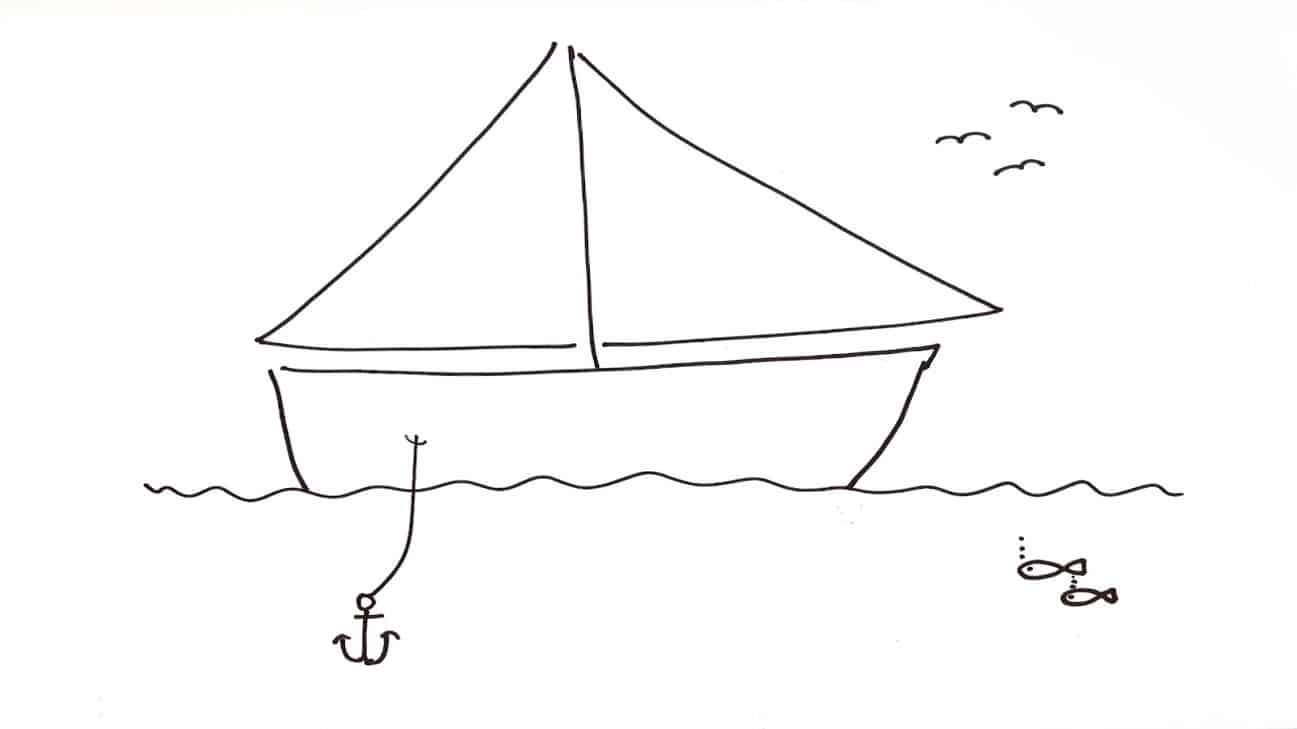 Sailboat Retrospective Template
Sailboat Retrospective Template
Get the group to draw a boat, a blue wavy line about 2/3 down the page is a good starting point. Teams should be free to design the style of their own boats with 3 requirements – it should have a body – a hull, sails and an anchor. Ideally have coloured markers, so the teams can get creative, it could be a yacht, a viking ship, a container ship, a cruise ship, pirate ship. Allow the team at least 5 minutes to draw their boat and encourage them to add any extras to the picture too. These can often indicate the mood of the team, good and bad metaphors – eg, sunshine, fish, sharks, icebergs, lightning bolts, stormy seas, flags, kraken, I have seen many props added!
TIP – It’s valuable not to give the team a template boat but let them draw their own, this gives ownership and buy in to the activity, it also helps to create a safe creative space for the team to be open and all contribute. Drawing the boat helps to act as an icebreaker and get all of the group participating and on the boat. Encourage all members of the group to pick up a pen and add to the picture. Encourage the addition of extra features to their picture, sunshine, fish, sharks or icebergs, ask gently if the additions represent anything particular or just doodling for fun.

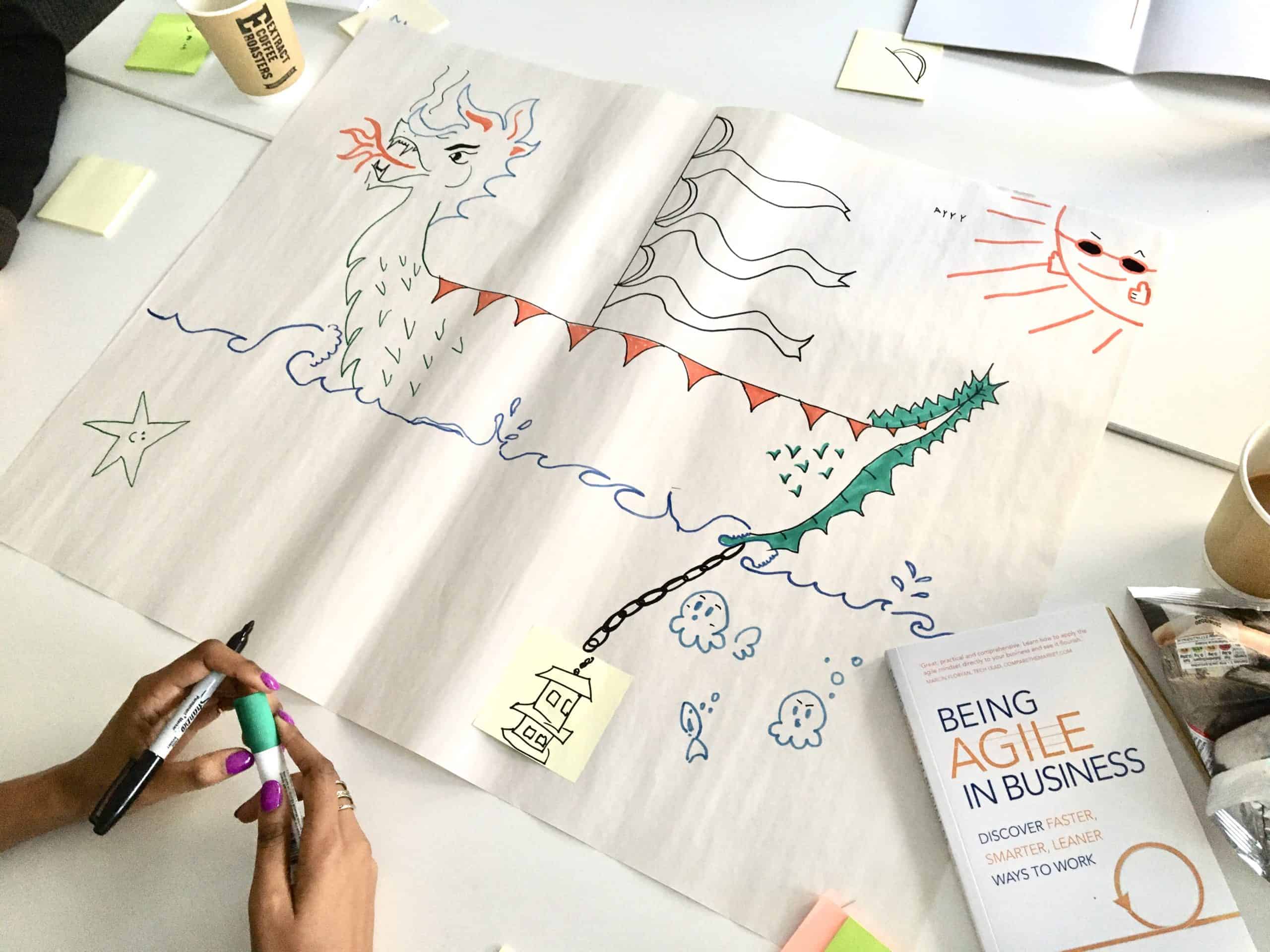
The sailboat metaphor works equally well to help facilitate a team discussion online, you can use a shared whiteboard tool like Miro, create a template in a shared document or use the metaphor in a slack chat.
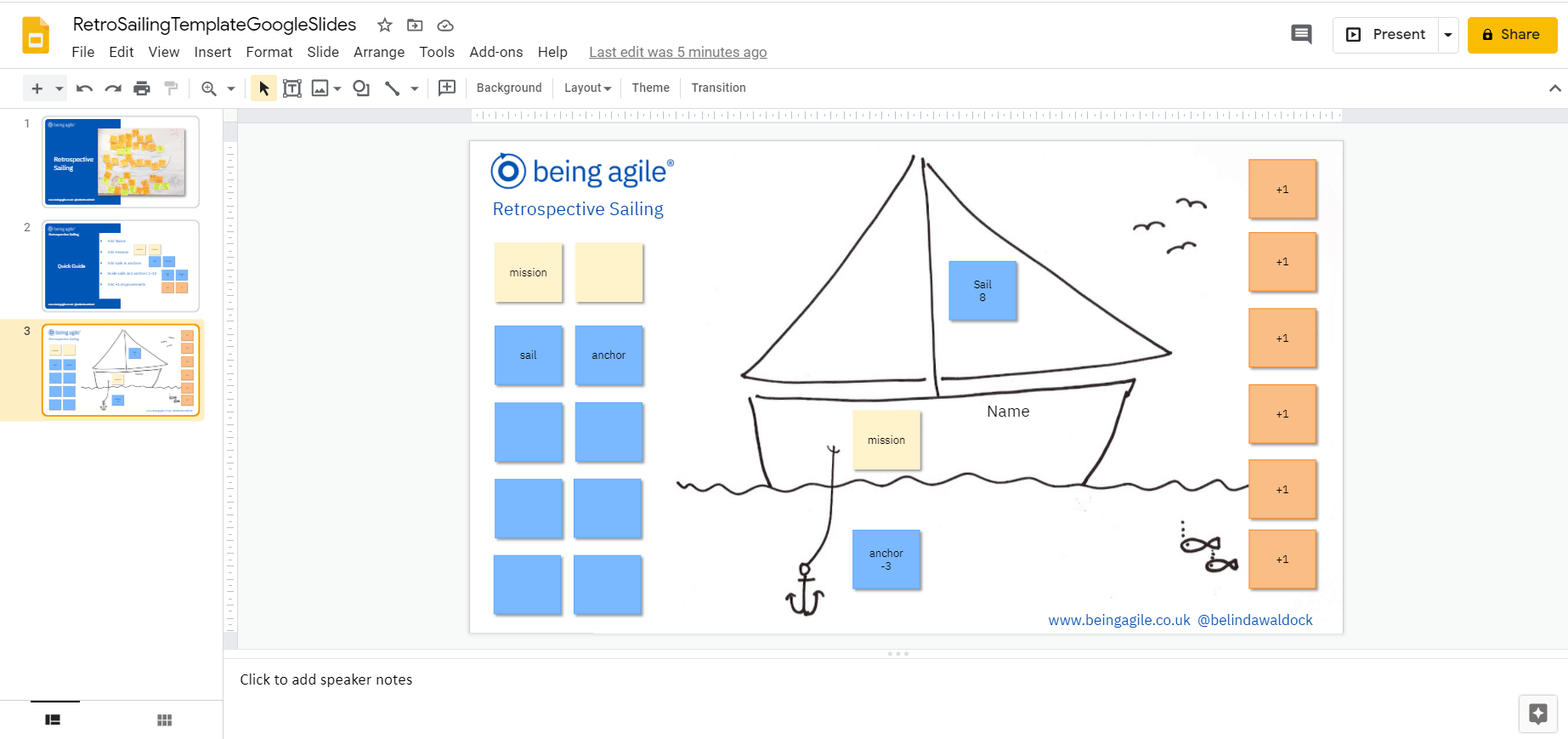
Download Slide Template
Use this template in google slides to group edit the boat as part of a remote meeting. https://beingagile.co.uk/wp-content/uploads/2020/10/RetroSailingTemplateGoogleSlides.pptx
Agree the topic/theme of the retrospective and name the boat accordingly.
Ask teams to name their boat themselves, it can be a practical name or a fun one, the key is conversation to agree the theme/topic of the retrospective. Fun names like Boaty McBoatface often come up, a sign of a playful (perhaps a little chaotic) group. Name can indicate the mood and position of the team currently, it can be whatever your team agree on. If you have a boat called Titanic, be cautious they have literally drawn a sinking ship, you will need your best facilitation skills handy, most of the time it’s not the final option, and filed as a joke opting for an alternative (but it’s an early flare to be aware of). Even for teams facing great challenges the game can be a positive way to find a way forward and more positive outlook and help avoid mutany!

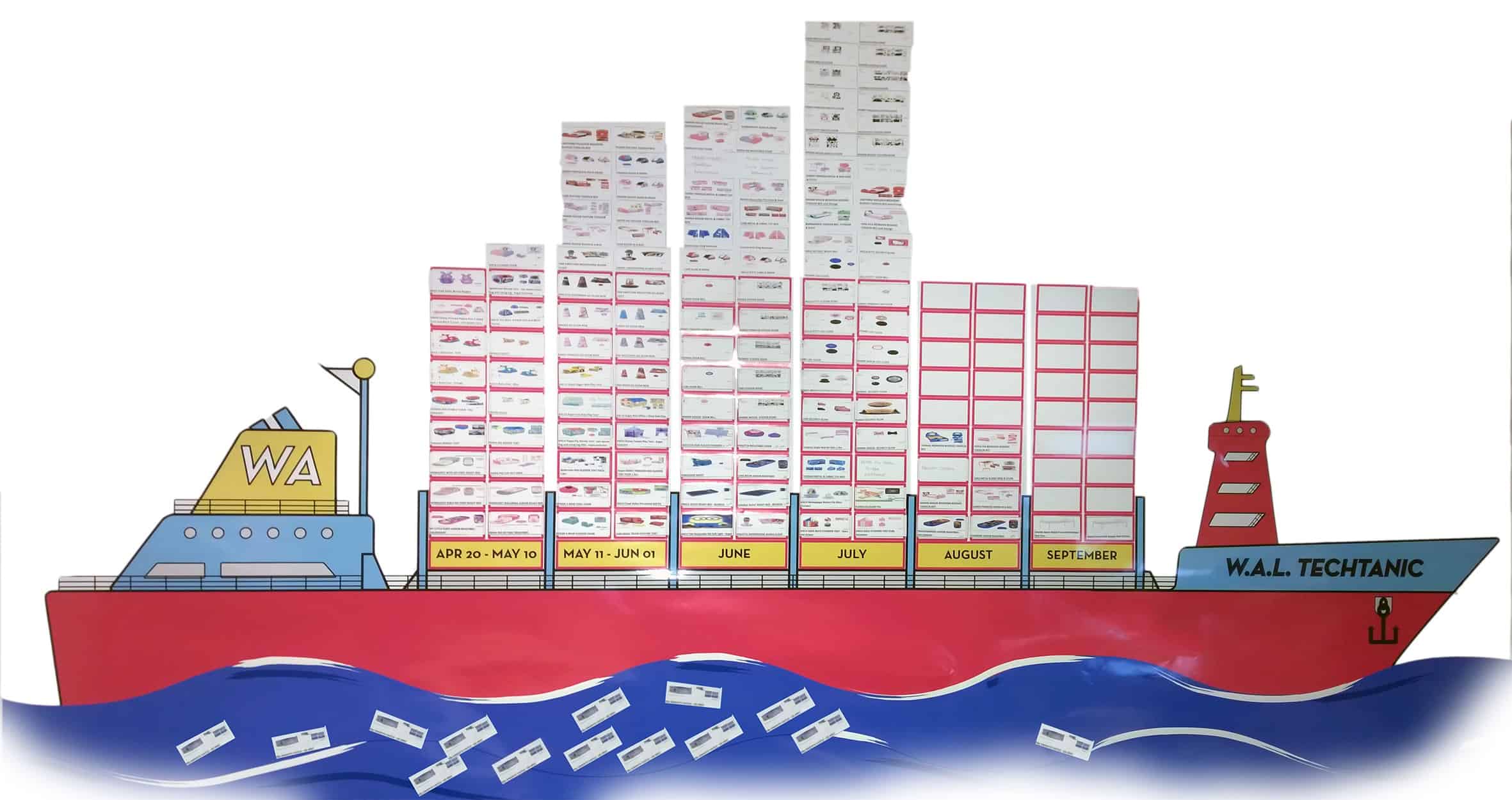
The name can tell you a lot about how the topic of the retrospective is going! Techtanic – a sinking ship!
Ensure every member of the group has post it notes and a sharpie – ideally all the same colour notes, save the other colour for later! There is no one ‘scribe’ in this game, all participants can contribute! Ask members of the group to think about what their boat represents, the topic or theme, this could be a project, an event, a product, the team, any topic. Ask them to put onto post its what their mission is, what they want to achieve, and what is their goal, add these post it notes to the hull of the boat. If more than one member of the group has the same thing, still add it to the boat, multiple notes show this mission is a shared one, and most likely important, group these together and discuss.

At any point should a member of the group wish to they can add another note to the mission, these often are identified when the team begin to talk about their sails and anchors next, equally post it notes can always be removed or amended, clarified or replaced as the game continues. The boat can be saved and revisited as part of sprint reviews, where sails and anchors can be reviewed, rescored, removed, new sails and anchors added.
Goal established – GROW
Ask the teams again using post it notes to add sails and anchors to their boat, make sure everyone has post its and a pen.
Sails represent things going well, what’s good, and what is putting the wind into their sails.
Anchors are the things that could be going better, the anchors holding them back and limiting progress.

Sometimes things can be sails and anchors, for example it could have good outcomes and bad, if this is the case ask for them to clarify this on separate notes. Encourage all members of the team to write and add notes. Ask the group to review the sails and anchors they have added, group them as appropriate. Encourage members to add duplicates even if the note is already there, there could be different angles (perspectives) and also multiple inclusion shows that it is possibly a larger sail or larger anchor, for example if everyone writes ‘team’ on a post it that creates a larger sail naturally. This can give a visual cue when grouping notes as to which are key topics and themes for the team.
Next ask the teams to scale their sales and anchors, their sails from +1 to + 10, is it a +1 or 2, a nice but relatively small in value sail, or a main sail that’s providing huge momentum, a +9 or +10. The anchors from -1, a minor impediment, or -10 this anchor has stopped us moving forward at all.

Teams should discuss each note, seek to clarify the meaning of the note and then decide as a group where on the scale it should be. Teams can vote by writing on post it notes, or using their fingers to all show their vote at the same time, once the team have discussed and scored one of two sails and anchors, the time to score others should decrease significantly and can be done using a higher or lower group voting approach. Is it a bigger or smaller sail/anchor than the previous. The key here is engaging group discussions, awareness and consensus on what the sail/anchor is and how it impacts the team. Sticky notes may need to be clarified with extra information, or split into multiple notes to score separately.
Reality Mapped – GROW
Once all sails and anchors have been discussed and scored, give each member of the team another colour post it note, again make sure everyone has notes so that they can add to the boat themselves. This second colour is for capturing activities and improvements to help raise sails further, and raise up anchors.

The key here is that we look for small incremental improvements that can be made, remembering we want to take an agile approach to becoming more agile. Ask groups to think of small actions that would raise one of the sails, or anchors on the boat by just one point, raise an anchor from a -6 to a -5, or raise a sail from a 2 to a 3. Capture ideas for improvements on post it notes and place them besides the relevant anchor or sail, or in a cloud or a map representing ideas/instructions for making their ship ‘go faster’.
Encourage the team to be imaginative with their ideas, get everyone to add their suggestions and then discuss.
The idea here is that the team then have actionable improvements that can be added to their work backlog and schedule them into future sprints of work as improvement activities alongside their day to day activities. This encourages Continuous Improvement in the team as well as time to regularly reflect, celebrate successes and flag up challenges.

Find out more about the agile canvas and download your copy here
More resourcesOptions identified – GROW
If there are numerous suggestions for raising sails and anchors then team activities like estimation games, MoSCoW prioritisation, dot voting to help discuss, rank and decide upon which improvements to take forward. Map the improvements/actions into the team backlog/future work or on a dedicated change and improvement board to help track and measure progress.
Encourage the group to discuss these actions individually, the goal, the current state, the desired impact, any blocks to implementing it and how this can be actioned. A person maybe allocated to the task, and an estimate of how big the task is, how long it will take and when it can be completed. New tasks or activities may be identified too which can be discussed, or an improvement may need to be broken down further.
Way Forward Agreed – GROW
Remind the team that it is not the aim to make everything a +10, this would unbalance the boat! Ideally we would like to raise our anchors, but be mindful that some anchors sometimes offer stability, and most sails don’t need to be 10/10 (perfect) to be effective. Often if we have one area which increases another might decrease and counteract it and unforeseen outcomes may occur.
Revisit your boat and review it as an ongoing retrospective tool, encourage the team to use boats to reflect on other topics and areas, put your boat on the wall to remind the team of their mission and purpose.
If there is more than one group in the room, it’s great to share content that has been added to the boats, and feedback regularly throughout the exercise, or at the end of the activity.
Timing, at pace this game can be run in 40 minutes on a theme that the team are already familiar with, with very good results, in effect the lack of time does encourage participants to write down what comes to mind without too much thought, scores are honest, decisions are made quickly, teamwork is encouraged. The downside is that there is less time for groups to discuss and gain a shared understanding. The exercise can also run for an afternoon, with 40 minutes for each section of the exercise, or anywhere in between, depending on the size and complexity of the chosen topic.
Topics : The game can be used for many themes and topics for review. It can also be used as a great ideation tool where we are looking for ideas to put wind in our sails, or to map our activity, such as a pirate ship with the goal of breaking your product into a new market!
Participant Numbers : can be used with individuals and small teams, for larger groups break into multiple boats with 6-8 people per boat. For groups with multiple boats, multiple topics can be covered and participants can choose a topic, or rotate to contribute to each boat. Include a gallery walk. It is an ideal game to photograph and circulate/share following the session.
More like thisBelow are examples of sailboats created at conferences and events with group participants. The workshop works well at conferences to review the conference or the theme of the conference as participants are all familiar with the topic. If you would like to run this workshop at your conference or our help facilitating this with your team please do get in touch Retrospective Sailing – Agile Workshop – Agile on the Beach 2017 from Belinda Waldock
You can also find a guide to Sailboat Retrospective game by watching this video, and the gallery of example boats below. Overview starts at 5min 50secs in

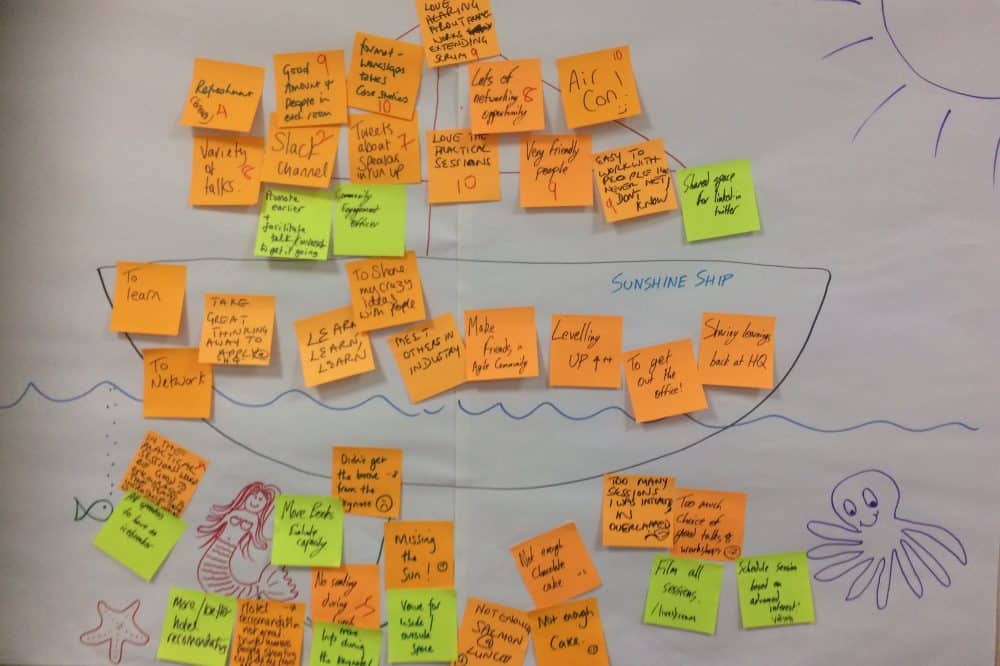
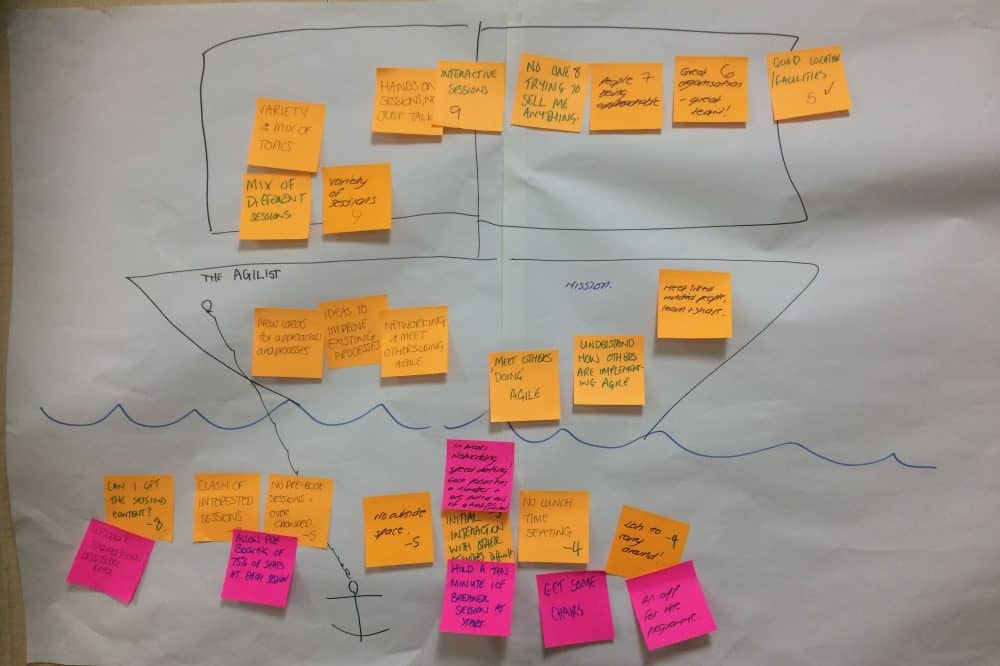
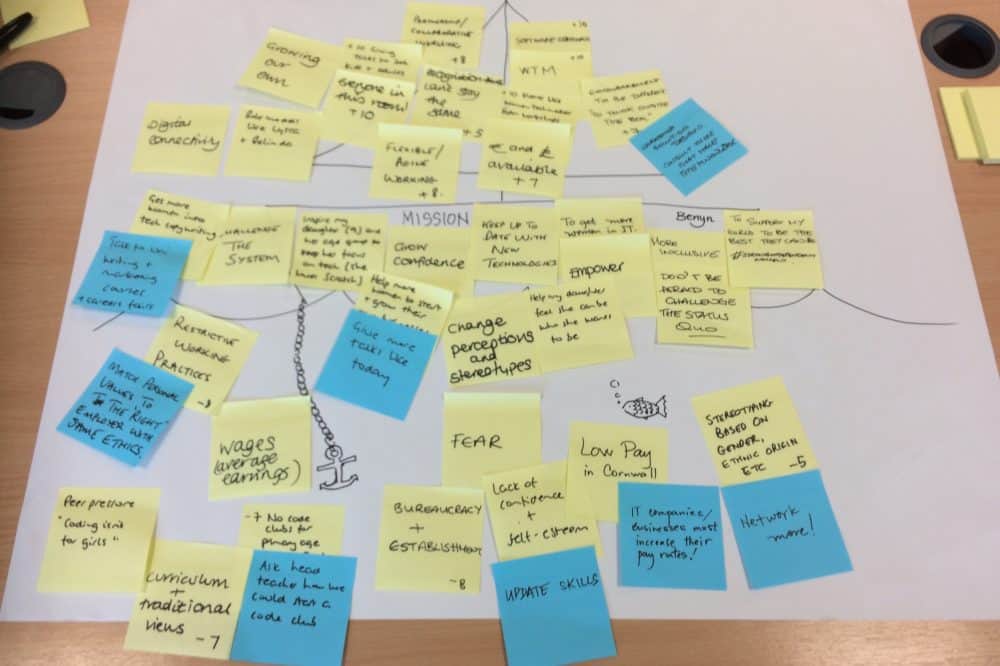
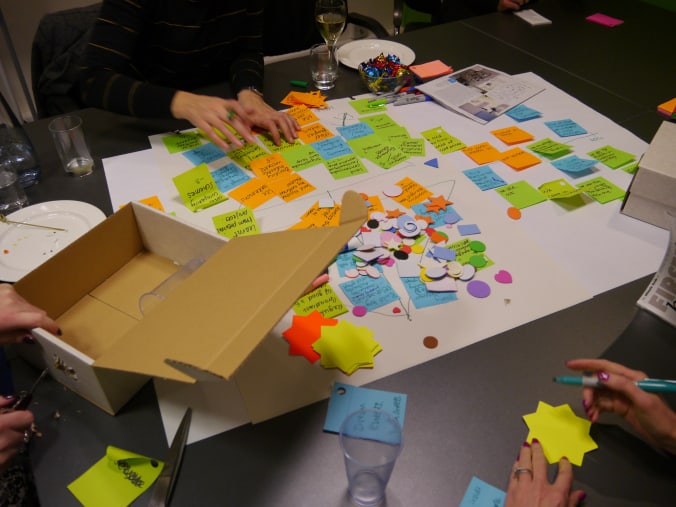
The game originated at Agile on the Beach Innovation Games workshop in 2012 – I was attending the Innovation Games Training Day with Jeff Brantley of Enthiosys and we were playing various games. The day aimed for us to learn about Innovation Games, how to facilitate them, and review how they could be applied to high growth small and medium size businesses in Cornwall as part of the EU growth programme we were working on. Its still one of my all time favourite Agile on the Beach workshops, and there have been a few!
One of the games we played was the Speedboat game. When we came to play the game I decided to draw a sail boat instead and build on the game, play with the ideas and thoughts spurring in my mind!
1 – Anchors are not something I associate with speed boats! I immediately found myself reacting to the idea and felt a need to improve/adjust it! We were in Falmouth, Cornwall, a tall ship seemed more fitting! Plus a sailboat felt like a more creative and fun thing to draw. I wasnt sure taking a game about speedboats would really fit the culture of businesses in Cornwall, a sailboat just seemed to be more appropriate!
2 – I loved the idea of the game but looking at just the negatives didn’t sit well with me as a solutions focused coach! It reminded me of SWOT analysis games, so often we identify all the issues, but then there is no step to look at how we improve them, for example in SWOT one powerful question is “do we have any strengths to mitigate against threats”. Similarly in the game there was the action of reflection to identify the Anchors, but no clear mission for the boat, and no clear facilitation for learning and improvement. The game was great, but it inspired me to play with the idea of a Sailboat and developing my own game to use with clients.
3 – If I drew a sail boat I could map what was holding us back, but also what was taking us forward. Plus I was studying coaching tools including Scaling and Grow, marrying the idea of a boat with sails and anchors, then scaling them and looking at how we could raise them by a point fit together really well.
A brilliant opportunity for iteration and innovation to improve and develop the game for use with cornish businesses. Innovating innovation games!
And Retrospective sailing was born!
In the workshop I played about with the idea, and immediately began using it with clients to help them reflect and identify improvements and opportunities to mitigate problems. Every one loved it, and still do!
This is one of the early boats facilitated with a team. The team was growing fast, the business had grown significantly and the teams were working to update and evolve their ways of working to manage the growth and ensure that business could continue to scale.
I love the intern post it note and the addition by the team of the word crucial! Centre sail and a +9, he finished his intern on a high! Before the game he told me he has no idea if he had been useful or not and was very nervous about adding it!
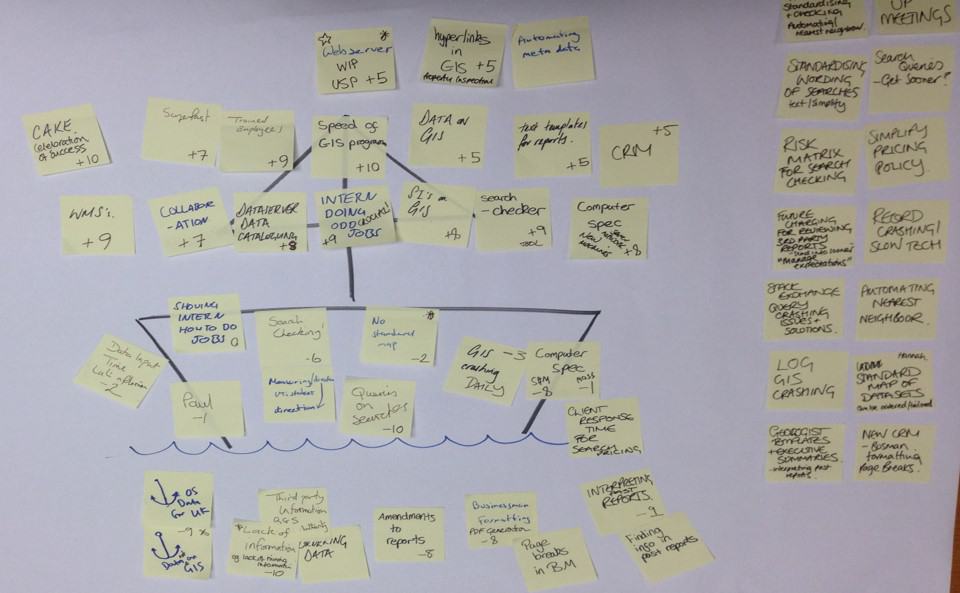

The +1 improvements to raise their sails and anchors were added to the back log of their change and improvement board. After seeing the server downtime report created the server got an immediate upgrade, making their boat go much faster and smoother!
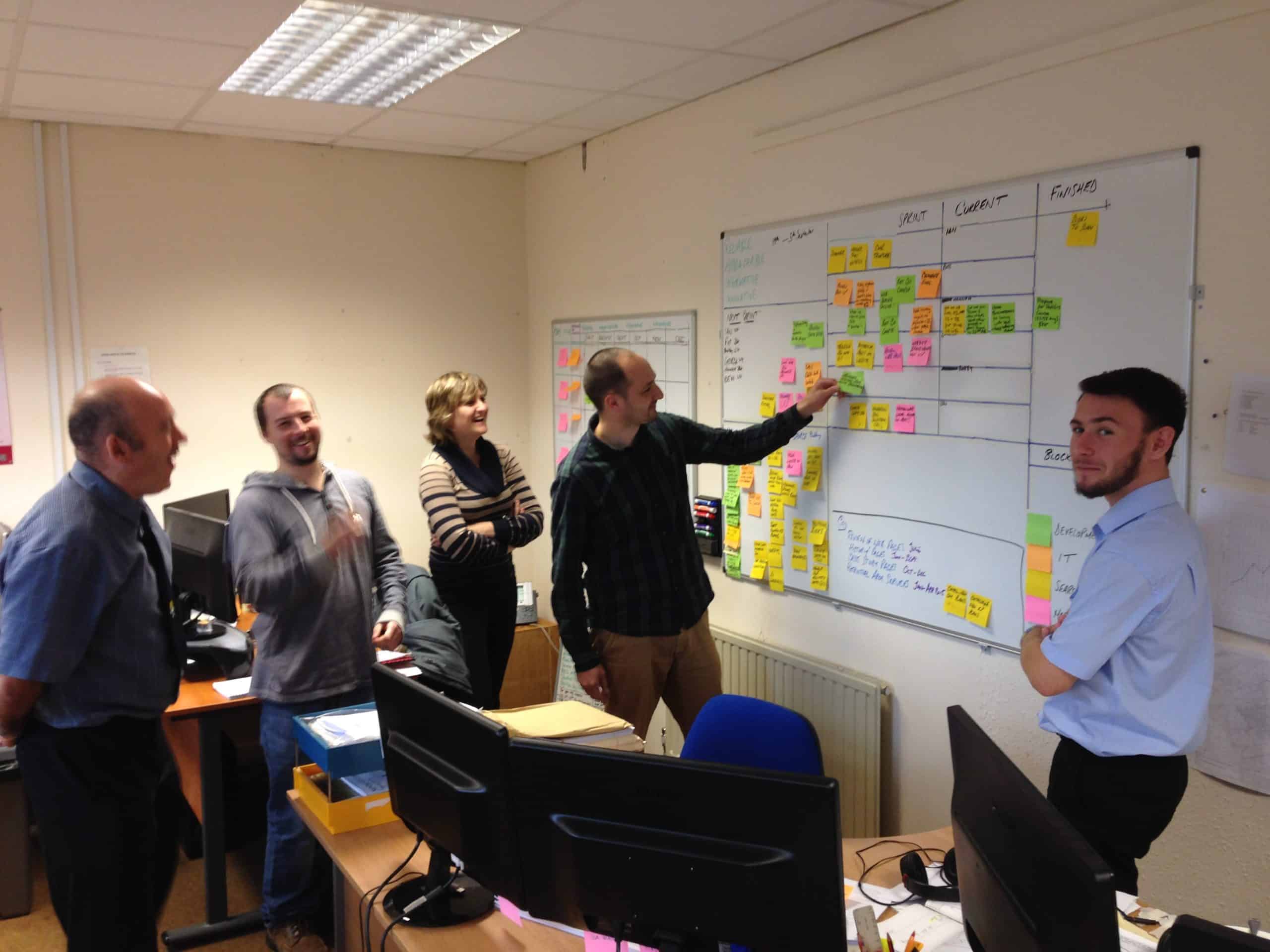
They then went on to build a pirate ship aimed at breaking into a new market, showing how adaptable the game can be for reviewing and reflecting on any mission, goal, or scenario a team would like to explore.
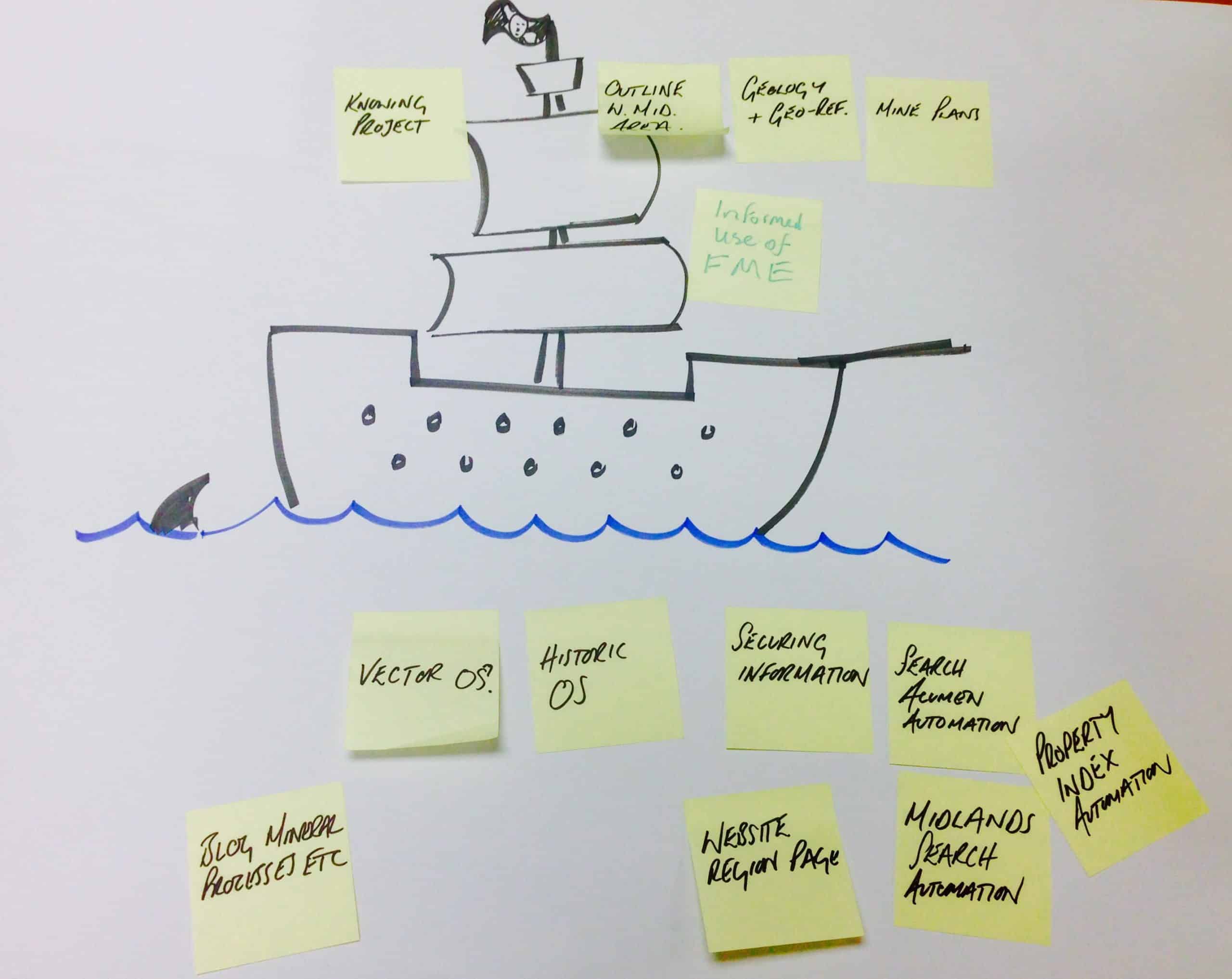
The differentiator of this game compared to others I have seen is that this includes scaling of the sails and anchors and the identification of actionable outcomes. It ensures that we not only reflect but we identify key actions and outcomes that help ensure that we are on course and any adjustments we need to make to our sails and anchors are captured to be acted upon as improvements. It is important to reflect on the Goal and current Reality, but it is also vital to ensure we identify Options to improve and agree a Way forward to ensure we gain maximum value. (GROW model – see my book for more details on GROW!).

I have played the game with individuals, small teams (upto 8 per boat is ideal) and groups of over 100 at conferences, yes, we created a small fleet! It has been tried, tested, and has evolved over the past 8 or so years with a wide array of teams, topics and settings and everyone always really enjoys it. The game is almost entirely self facilitated by the team themselves and encourages them to take responsibility and action.
I hope you find this guide useful, if you adopt and like this variety of Retrospective Sailing then please share it more widely, a credit is always appreciated, and I always love to see photos of boats by email and social media, do share! belinda@beingagile.co.uk @belindawaldock or @beingagile
Enjoy being agile!
Belinda @belindawaldock
Hands-on team retrospective.
Facilitated retrospective with your team

A simple and straightforward guide to agile working, covering the application of agile in project management, product development, team performance and business management for any business professional.
Online Course